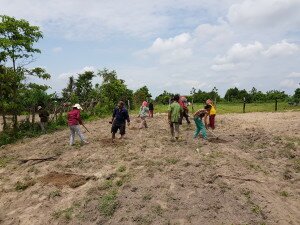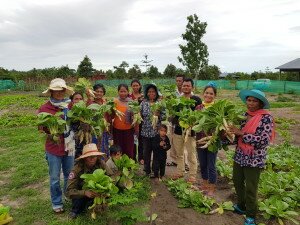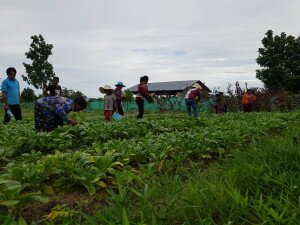Significant new investment in NCD prevention and control is opportunity to strengthen Cambodia’s public health system and build momentum for action
06 September 2018
We are at a crossroads in Cambodia: cancer, cardiovascular diseases, diabetes and chronic respiratory diseases, the so-called ‘noncommunicable diseases’ (NCDs) are already the largest cause of mortality, and the rate is rising. They cause 61.3 percent of deaths but receive the least funding and attention across the board. People living with NCDs are also hit financially: they spend ten times as much on healthcare as those without NCDs. Clearly, huge action is needed to limit preventable deaths and work towards the goal of Universal Health Coverage (UHC).
Against this backdrop, a major new financial contribution of US$4.5 million has been committed to strengthen and expand NCD services nationwide. The investment, by German bank KfW, is the largest single investment in NCDs. It also provides an opportunity to reflect on where we are, overall, in the NCD response, and examine how this investment fits into the bigger picture of what still needs to be done.
NCDs impose a significant financial burden on households in Cambodia. For people living with an NCD, out-of-pocket expenditure on health accounts for about a third of their monthly income, compared to only 3 percent of income for people without an NCD. This results in catastrophic health expenditure.
Efforts to achieve the UHC agenda – ensuring access to quality health services without financial hardship – are gaining some momentum in Cambodia, with clear policies to expand financial protection through social health protection schemes and reduce financial barriers to access. Addressing NCDs is a crucial part of delivering UHC, but without a balance between the upstream, multisectoral policies for prevention, and the downstream, health-sector interventions to improve access to quality health services, efforts will have limited success.
GIZ Cambodia’s Social Health Protection Program is a key partner in the NCD response, providing financial and technical support to the Ministry of Health’s Preventive Medicine Department (PMD). PMD have established basic screening and treatment services for hypertension and diabetes in a small number of health centers, based on the WHO Package of Essential NCD services (PEN). Financial support is provided by GIZ to implement PEN in 11 health centers in Kampong Thom and Kampot provinces.
Since 2007, 26 NCD clinics have also been established, at district and provincial referral hospitals, to treat more complicated cases. However, these services are currently not adequate for the scale of the burden in Cambodia.
The US$4.5 million, committed by KfW to the Cambodian Health Equity and Quality Improvement Project (H-EQIP) will support supply-side readiness and the availability of key NCD services, specifically cervical cancer, hypertension, and diabetes screening and treatment services. This funding is particularly significant considering the extremely small global NCD investment: a mere 1.3 percent of total Development Assistance for Health (DAH).
Funding for NCDs is rare: globally NCDs account for 70 percent of health-related deaths but receive less than 1.3 percent of development assistance of global health budgets. This investment is an opportunity to build new momentum and commitment to NCDs in Cambodia.
GIZ will continue to support the MOH’s Preventive Medicine Department, who will be the lead implementing body responsible for scaling up NCD services. NCD service delivery is also the focus of two further projects launching in 2018, funded by Novo Nordisk, in collaboration with GIZ and PMD. This includes a 3-year project ‘Changing Diabetes in Children’ (CDiC) and a 1-year project ‘Changing Diabetes in Adults’ (CDiA). CDiC aims to improve access to care for children and young people with type 1 diabetes and CDiA will strengthen the capacity and infrastructure of the existing NCD clinics.
Other key developments this year include the endorsement of the Multisectoral Action Plan on NCDs by the Cambodian Prime Minister, setting the tone for a whole-of-government response; new data on the prevalence of NCD risk factors (STEPS Survey 2016); and joint UNDP-WHO NCD investment case, currently underway, which will provide the economic case for investing in the prevention and control of NCDs.
Significant investment to strengthen services for those most at-risk is of course necessary, but simply treating our way out of the NCD epidemic is not an option. The new investments of 2018 should be celebrated and leveraged to build greater momentum for action. We are at a critical point. New alliances need to be formed, accountability strengthened, and the narratives must speak the language of decision-makers. Ultimately, a whole-of-government and whole-of-society approach is needed to reverse current trends.
Charlotte Aberdein (GIZ SHPP)
Improving livelihoods with vegetable production – GIZ Cambodia
កែលម្អជីវភាពតាមរយៈផលិតកម្មបន្លែរបស់អង្គការ -
ជីអាយហ្សិតកម្ពុជា
បន្លែជាច្រើនប្រភេទដែលដាំដុះលើផ្ទៃដីទំហំ ៣៥ម x ៦០ម ធ្វើឱ្យលោកស្រីទុំ អ៊ិន ពោរពេញដោយស្នាមញញឹមយ៉ាងរីករាយ។ “ខ្ញុំសប្បាយរីករាយណាស់ដែលគម្រោង ILF របស់អង្គការGIZបានជួយគាំទ្រដល់ពួកយើងដើម្បីបង្កើតទីតាំងបង្ហាញនេះ … ច្រើនទៀត >>>
The numerous types of vegetables on the 35 m x 60 m plot of land make Mrs. Tum En smile joyfully. “I am so happy that GIZ ILF has supported us to establish this demonstration plot and trains us adequately so that we can increase our income through better growing techniques… More >>>
Improving livelihoods with vegetable production – GIZ Cambodia
31 August 2018
កែលម្អជីវភាពតាមរយៈផលិតកម្មបន្លែរបស់អង្គការ -
ជីអាយហ្សិតកម្ពុជា
បន្លែជាច្រើនប្រភេទដែលដាំដុះលើផ្ទៃដីទំហំ ៣៥ម x ៦០ម ធ្វើឱ្យលោកស្រីទុំ អ៊ិន ពោរពេញដោយស្នាមញញឹមយ៉ាងរីករាយ។ “ខ្ញុំសប្បាយរីករាយណាស់ដែលគម្រោង ILF របស់អង្គការ GIZ បានជួយគាំទ្រដល់ពួកយើងដើម្បីបង្កើតទីតាំងបង្ហាញនេះ ហើយក៏បានបណ្តុះបណ្តាលយើងគ្រប់គ្រាន់ដើម្បីឱ្យយើងអាចបង្កើនប្រាក់ចំណូលរបស់យើងតាមរយៈការបង្កើនបច្ចេក
ទេសក្នុងការដាំដុះ។ យើងសង្ឃឹមថា ក្រុមគ្រួសារដទៃទៀតនៅក្នុងភូមិរបស់យើង បានមកមើលគម្រោងសួនបន្លែបង្ហាញនេះរបស់យើងដើម្បីរៀនសូត្រ ហើយអាចយកចំណេះដឹងថ្មីៗនេះ ទៅអនុវត្តនៅក្នុងសួនច្បារគ្រួសាររបស់ពួកគេ “។
គម្រោងសួនបង្ហាញនេះ គឺជាផ្នែកមួយក្នុងចំណោមគម្រោងបួនដែលគម្រោង ILF II នៃអង្គការGIZ បានផ្តួចផ្តើមឡើងនៅក្នុងភូមិចំនួន៤ ក្នុងខេត្តកំពង់ឆ្នាំង។ ក្រោមកិច្ចសហការជាមួយក្រសួងរៀបចំដែនដីនគរូបនីយកម្មនិងសំណង់ គម្រោង ILF នៃអង្គការGIZ បានជួយគាំទ្រដល់សម្បទាននិកក្នុងខេត្តទាំង៥ ដើម្បីប្រើប្រាស់ដីដែលពួកគេទទួលបាន និងដើម្បីកែលម្អជីវភាពរស់នៅនិងសន្តិសុខស្បៀងរបស់ពួកគេ។ តួនាទីចម្បងនៃផលិតកម្មបន្លែ អាចជួយបង្កើនរបបអាហារចម្រុះ និងរួមចំណែកដល់ការបង្កើនប្រាក់ចំណូលគ្រួសារឱ្យកាន់តែខ្ពស់។
ជាជំហានដំបូង ក្រុមអ្នកផលិតបន្លែត្រូវបានបង្កើតឡើងនៅតាមភូមិនិមួយៗ ហើយត្រូវបានបណ្តុះបណ្តាលជាជំហានៗ ។ មិនយូរប៉ុន្មានបន្ទាប់ពីនេះ សមាជិកក្រុមអ្នកផលិតបន្លែទាំងនេះ នឹងយកចំណេះដឹងថ្មីៗរបស់ពួកគេ ទៅអនុវត្តនៅក្នុងសួនបន្លែគ្រួសាររបស់ពួកគេ ប៉ុន្តែក៏ត្រូវការការណែនាំបច្ចេកទេសបន្ថែមទៀតផងដែរ។ ដូចគ្នានេះផងដែរ យើងអាចសង្កេតឃើញថា ចំនួនសមាជិកនៃក្រុមអ្នកផលិតនេះមានចំនួនទាប ដូច្នេះសួនបង្ហាញដែលបានផ្តួចផ្តើមឡើងភូមិនីមួយៗអាចផ្សព្វផ្សាយចំណេះដឹងដល់កសិករដទៃ។ សួនបង្ហាញនីមួយៗ ផ្តល់ជូនកសិករពី ១០ ទៅ ២០រូប នូវទំហំដីប្រហាក់ប្រហែលជា ១០ម x ១២ម ដែលពួកគេអាចដាំបន្លែ និងដំណាំផ្សេងទៀត។ ការធ្វើដូច្នេះ អាចជួយកសិករជាច្រើនឱ្យដាំបន្លែបានពេញមួយឆ្នាំ ទោះជាគ្រួសារជាច្រើនជួបប្រទះនូវការខ្វះខាតទឹកនៅរដូវប្រាំងក៏ដោយ។ ចាប់តាំងពីការបង្កើតសួនបង្ហាញនេះកាលពី១ខែកន្លះកន្លងមក កសិករជាច្រើនបានខ្នះខ្នែងដាំបន្លែដោយគ្មានប្រើសារធាតុគីមី និងធ្វើពិពិធកម្មផលិតកម្មរបស់ពួកគេដែលរួមមានម្រុំ ស្គួយផ្អែម សណ្តែកផ្កាយ និងស្លឹកគ្រៃ។ ឥឡូវនេះកសិករទី១ អាចប្រមូលផលបន្លែរបស់ពួកគេជាលើកដំបូងហើយលក់វាទៅឱ្យអ្នកលក់បោះដុំដែលមានតម្លៃខ្ពស់ជាងតម្លៃទីផ្សារ
ធម្មតាដោយសារគុណភាពល្អនៃបន្លែ។ ប្រាក់ចំណូលដែលទទួលបានគឺប្រហាក់ប្រហែលនឹងចំណូលនៃអ្នកធ្វើការរោងចក្រ បូករួមនឹងការមិនចំណាយពេលវេលា និងប្រាក់កាសចំណាយសម្រាប់ការធ្វើដំណើរនិងចំណាយលើម្ហូបអាហារធ្វើឱ្យការផលិតបន្លែកាន់តែមានផល
ចំណេញជាងការទៅធ្វើការនៅខាងក្រៅ។
បច្ចុប្បន្នសមាជិកក្រុមអ្នកផលិតបន្លែត្រូវបានបណ្តុះបណ្តាលអំពីខ្សែសង្វាក់ផលិតកម្ម ដោយគម្រោង ILF នៃអង្គការ GIZ ដើម្បីកែលម្អការរៀបចំក្រុមផលិតករ និងពង្រឹងជំហរទីផ្សាររបស់ពួកគេ។ ហើយតាមរយៈភាពជោគជ័យរបស់អ្នកផលិតបន្លែដំបូងគេ កសិករជាច្រើនចាប់អារម្មណ៍នឹងចូលរួមក្នុងក្រុមនេះក្នុងពេលឆាប់ៗខាងមុខនេះ។

ដើមឡើយ ក្រុមអ្នកផលិតបានរួមគ្នាក្នុងការដាំម្រុំនៅលើសួនបង្ហាញ
In the beginning, the producer group planted moringa together on the demonstration plot
11
11
The numerous types of vegetables on the 35 m x 60 m plot of land make Mrs. Tum En smile joyfully. „I am so happy that GIZ ILF has supported us to establish this demonstration plot and trains us adequately so that we can increase our income through better growing techniques. We hope that all other families in our village visits our demonstration plot to learn and then apply their new knowledge in their own home gardens“.
The demonstration plot is one of four that the GIZ project ILF II (Improvement of Livelihoods and Food Security) has initiated in a total of four villages in the Cambodian province Kampong Chhnang. In cooperation with the Ministry of Land Management, Urban Planning and Construction, GIZ ILF supports land recipients in five provinces to use their allocated land in order to improve their livelihood and food security. A main role plays the production of vegetables as these improve and diversify the family diet as well as contribute to a higher household income.
As a first step, vegetable producer groups were established in each village and trained in consecutive steps. Soon, all members applied their new knowledge in their own home garden, but needed further technical guidance. Also, it was observed that the number of producer group members stayed low, hence the demonstration plots were initiated in each village to spread the knowledge to other farmers. Each of these demonstration plots offer 10-20 farmers a piece of land of approx. 10 m x 12 m on which they can grow vegetables and other crops. This helps many farmers to produce vegetables all year round as many families experience a lack of water in dry season. Since the establishment of the plots 1.5 months ago, many farmers have eagerly grown vegetables without the use of chemicals and diversified the production with moringa, sorghum, Sacha Inchi and lemon grass. Now, the first farmers could harvest their vegetables for the first time and sell it to a wholesaler for a price higher than the usual market price due to the good quality. The generated income is approx. as high as the income of a day of factory work, however no time and money need to be spent for transport and food which makes the vegetable production more profitable.
Currently the vegetable producer group members are trained in ValueLinks by GIZ ILF in order to improve the organisation of their producer group and strengthen their market position. And through the successes of the first vegetable producers, certainly many more farmers will join the group very soon!
Costing of Health services in three Provinces
13 August 2018
Healthcare policy decisions must be based on economic and epidemiological evidence. While knowledge of the epidemiological situation in Cambodia is considerable, little is known about the cost of healthcare services in this country. Existing data is obsolete and frequently not based on a standard methodology. This study was conducted by GIZ in partnership with the Cambodian Ministry of Health (MOH) in 2017, based on data from 2016. The objectives were first, to calculate the unit cost of public healthcare services in Cambodia (health centers, primary and secondary hospitals) as a foundation of evidence-based decision-making; and second, to demonstrate that costing of healthcare services in Cambodia is feasible and can develop into a routine system
The study involved 25 public health facilities: 16 health centers without beds, 4 health centers with beds, 2 provincial hospitals that deliver the “complementary package of activities – level 3″ (CPA3), two CPA2 district hospitals, and one CPA1 hospital.
The fndings show that costing of public healthcare services following a standard methodology is feasible in Cambodia. The results can also be used for managers at various levels of the health system. However, the sample must be broadened, and data collection must become routine practice in order to base policy- and healthcare decision-making on economic evidence. For this purpose, administrative standards in health facilities, operational districts and provincial health departments must be strengthened.
Introduction to Traditional Cambodian Lacquer

Master lacquerer (Eric Stocker) explaining the different layers required during application of natural lacquer.
08 August 2018
Amongst their continuous conservation and restoration efforts in the Angkor Park, the APSARA Stone Conservation Unit (SCU) is currently working on two prestigious late 12th-century Buddha statues at Prasat Pre Rup (as previously mentioned here). Both statues are, as one would expect, typically covered in various coats and layers of natural lacquer and polychromy, including decorative embellishments and faint traces of gold leaf. In order to successfully carry out … More >>>




